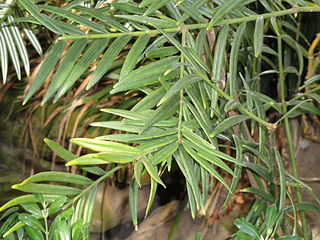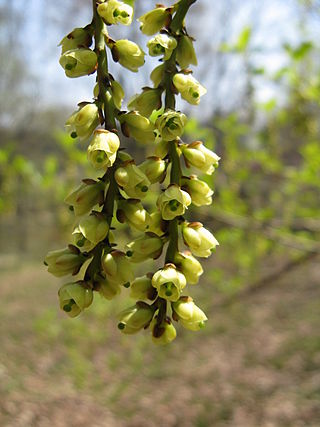
Voacangine is an alkaloid found predominantly in the root bark of the Voacanga africana tree, as well as in other plants such as Tabernanthe iboga, Tabernaemontana africana, Trachelospermum jasminoides, Tabernaemontana divaricata and Ervatamia yunnanensis. It is an iboga alkaloid which commonly serves as a precursor for the semi-synthesis of ibogaine. It has been demonstrated in animals to have similar anti-addictive properties to ibogaine itself. It also potentiates the effects of barbiturates. Under UV-A and UV-B light its crystals fluoresce blue-green, and it is soluble in ethanol.
Amanita parvipantherina, also known as the Asian small panther amanita, is a species of agaric restricted to Yunnan province in China. It is strongly associated with the Yunnan Pine Pinus yunnanensis. It fruits in July and August.

The Chinese leaf warbler is a species of Old World warbler in the family Phylloscopidae. Its natural habitats are subtropical or tropical dry forests and subtropical or tropical high-altitude shrubland. It is found only in China.

Amentotaxus yunnanensis, the Yunnan catkin yew, is a species of conifer in the yew family, Taxaceae. It is native to Laos, Vietnam, and Guizhou and Yunnan in China.

Pinus yunnanensis, the Yunnan pine, is a species of conifer in the family Pinaceae. It is found in the Chinese provinces of Yunnan, Sichuan, Guizhou, and Guangxi.
Glyphoglossus yunnanensis, also known as Yunnan squat frog or Yunnan small narrow-mouthed frog, is a species of frog in the family Microhylidae. It is found in southern China and northern Vietnam; it probably occurs in adjacent Laos and in eastern Myanmar.
Nanorana yunnanensis, commonly known as Yunnan paa frog, Yunnan spiny frog, Bourret's paa frog or Bourret's frog, is a species of frog in the family Dicroglossidae. It is found in southwestern China, Vietnam, Myanmar, northern Thailand, and likely in the intervening Laos. Its natural habitats are small and large streams in montane forests, scrub vegetation and grasslands, and it has also been found in ditches. It is threatened primarily by collection for human consumption, but also by habitat loss caused by agricultural development and infrastructure development.

The Yunnan box turtle is a species of turtle in the family Geoemydidae. It is believed to be endemic to Yunnan, China and was suspected to be extinct since the early 20th century; the last verified specimen was collected in 1940.
Bulleyia is a genus of plants in the family Orchidaceae. It is either epiphytic or lithophitic, growing on tree branches or on rocks on steep hillsides. The genus is monotypic and represented only by Bulleyia yunnanensis, native to the Himalayas of Assam, Bhutan, eastern India and Yunnan.
Trimeresurus yunnanensis, commonly known as the Yunnan bamboo pitviper, is a venomous pitviper species endemic to China.

Malus yunnanensis is a species in the genus Malus, family Rosaceae, with the common name Yunnan crabapple. In Mandarin Chinese, it is called “滇池海棠”.
The Yunnan horse is an extinct genus of equine that was present in East Asia during the Pleistocene very likely as a grazer on open tracts of grassland. It was a small equine comparable in size to the modern Przewalski's horse.
Schizothorax yunnanensis is a species of ray-finned fish in the genus Schizothorax which is found in Yunnan.

Stachyurus is the only genus in the flowering plant family Stachyuraceae, native to the Himalayas and eastern Asia. They are deciduous shrubs or small trees with pendent racemes of 4-petalled flowers which appear on the bare branches before the leaves. The plants have leaves with serrate margins.
Vitis yunnanensis is a species of liana in the grape family native to the Chinese province of Yunnan. It is a forest dweller, found at various elevations between 500 and 1800 meters. In August it bears globular berries.
Musa yunnanensis, commonly known as either Yunnan banana or wild forest banana, is a recently described plant in the banana and plantain family native to Yunnan in southern China. The type specimen was collected in 2005 in Xishuangbanna, at an elevation c. 1,150 meters.
Xenocypris yunnanensis, the Kunming nase, is a species of ray-finned fish in the genus Xenocypris. It is endemic to Lake Dianchi in Yunnan Province, China. The species started to decline in the 1970s and has not been caught in the lake after two specimens were collected in 1985; it may be extinct. Its demise is likely due to introduced fish species, grass carp. It was also impacted by over-fishing and pollution. They grow to a maximum length of 23 cm. They are dark grayish with a silvery white belly, gray dorsal fin, reddish anal fin and orange red caudal fin. They have a rounded belly, blunt snout, eyes on the lateral of their heads, small and transverse mouth.
The Yunnan bush rat is a species of rodent from the family Muridae. It has just recently been released from synonymy with the Manipur bush rat, and so there is very little information about it. It was recognized as a separate species due to its much larger body size in comparison to the Manipur bush rat, relatively shorter tail, pure white underparts as opposed to gray, significantly shorter diastema, and shorter palate in relation to its skull. It is located only in Yunnan province of the People's Republic of China, where it known only from Tongbiguan Nature Reserve in Ruili City.

Pterolophia is a genus of longhorn beetles of the subfamily Lamiinae, containing the following species:







